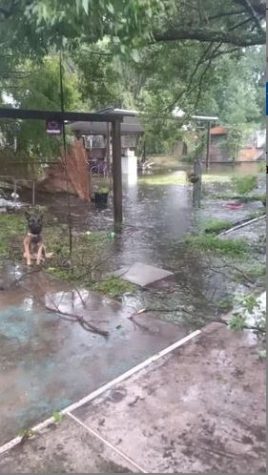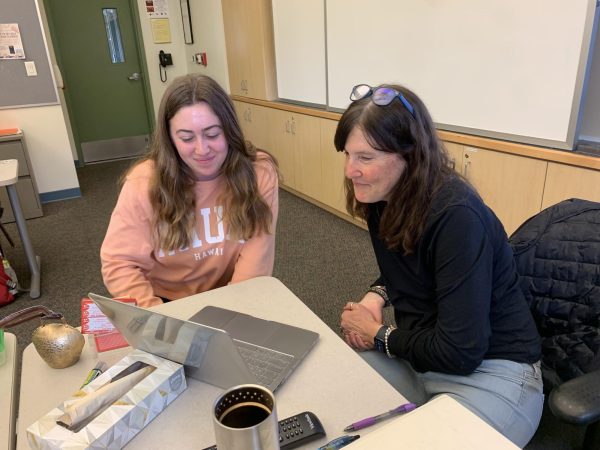Tyrone Alumni Experience Ian Firsthand
November 7, 2022
Wading through waist-deep water, her apartment destroyed and struggling to get her disabled father to safety, Tyrone native Kira Galbraith experienced the power of Hurricane Ian firsthand.
“Everything happened so fast,” said Galbraith.
On the afternoon of September 28th, Hurricane Ian struck the gulf coast of Florida as a category 4 storm with 150 miles per hour wind and flooding in many cities along the coast.
State officials blamed at least 119 deaths and thousands of injuries on the hurricane. Authorities have called Ian Florida’s deadliest hurricane since 1935.
The storm is estimated to have caused over $67 billion in damages. The damage amount accounts for the loss of homes, businesses, and natural resources across Florida and the Carolinas.
Galbraith was one of many Tyrone natives who were impacted by the hurricane. Shortly after the hurricane hit, the Eagle Eye asked former Tyrone residents who were affected by Hurricane Ian to tell their stories.
The following five alumni responded to the Eagle Eye and shared their accounts of Hurricane Ian:
- Kira Galbraith – Class of 2003
- Chad Reese – Class of 1988
- Nicole Schoch – Class of 1999
- John Morrow – Class of 1977
- Richard Webster – Class of 2021
- Morgan Bridges – Class of 2018
Kira Galbraith – Class of 2003
Of the five alumni who responded to our request for stories, Class of 2003 graduate Kira Galbraith was the most seriously affected by the hurricane.
Galbraith lost most of her possessions and had to evacuate her rapidly flooding home during the storm.
Galbraith, her boyfriend, and her father live just a mile and a half from the gulf coast in Naples, Florida. They were about 30 minutes south of the eye of Hurricane Ian and experienced significant flooding due to the storm surge.
As Ian made landfall in Naples with winds of nearly 150 mph, over two million people lost power, and the storm surge sent floods of water straight toward Galbraith and her family.
“Our home was filled with water and had a resting level of four and a half to five feet. Along with the water in our apartment, the sewage system failed, so sewage waste went through our home,” said Galbraith (Click the video attached to this story to see the damage to Galbraith’s apartment).
She and her family lost almost all of their belongings except for a few items on the top shelf in each bedroom closet and two shelves in her hall closet.
“We were in our home when the hurricane hit. Standing in my living room as water filled my home, saving our pets and my dad was the priority. My boyfriend and I worked together and did just that,” said Galbraith.
The storm surges sent several feet of water to our neighborhood. Our home was filled with water and had a resting level of 4.5 – 5 feet in height. Along with the water in our apartment, the sewage system failed, and sewage waste went through our home
— Kira Galbraith
Fortunately, Galbraith’s car was parked on higher grounds about a quarter of a mile away from their home. Her boyfriend Matt took the first load of cats to their vehicle and flagged down help to get Galbraith and her father to safety.
Galbraith will be forever grateful for the generosity of strangers.
“As Dad, myself, and our last cat exited the house, we were in waist-deep water. Everything happened so fast. Thankfully, as we got to the end of the sidewalk, the two men that selflessly decided to help us put my father [on Matt’s back], and Matt held him on there, guiding him to the truck,” said Galbraith.
Galbraith and her boyfriend are caretakers for Galbraith’s father, who is an amputee. While trying to escape the flooding of their house, her father had to hop with his walker while Galbraith pushed his wheelchair through the water with one hand, while holding her cat in a pet carrier above her head with her other hand.
The family and their cats were all able to make it to their vehicle safely and drive as far east as they could. They ended up at a hotel in Fort Lauderdale on the east coast of Florida near relatives for two weeks.
“Beyond the flooding and rain, we experienced extreme winds ranging from 40 to 80 mph; we felt these winds as they pushed our car as we drove away. There were many trees and power
lines down that we saw as we traveled east,” said Galbraith.
Galbraith is already putting the pieces of her life back together, but it will be a while before things will be back to normal in Naples.
“The stress of finding a new place to live was the most significant factor that impacted us. Most available apartments or houses for rent either don’t accept pets or have a pet limit,” said Galbraith.
Unwilling to leave her pets or rehome them to find a place to live, Galbraith struggled to find a new home. She stated how she and her family will slowly start to gain more belongings and rebuild their home. The thing Galbraith is most thankful for is that she and her family are alive and safe.
Growing up in central Pennsylvania, hurricanes were not something for which she was prepared, but Galbraith feels like her upbringing and her study of psychology give her an advantage in this situation.
To everyone who has helped us, we could never express our gratitude for them for what they have done for us. Several people have gone above and beyond to aid us in our post-hurricane journey; they are true blessings. We are thankful for everyone who reached out with concern, advice, and prayers. Staying positive is critical; being empowered and uplifted has brought tremendous value to us
— Kira Galbraith
“We feel that our childhoods prepared us for this. We are fighters full of reliance. Learning emotional intelligence and consciousness levels was a big help during this emergency. My learning journey of studying our brains, emotions, and behaviors and the knowledge gained from my psychology courses has significantly helped with my mental health status,” said Galbraith. “At the moment, Matt and I agreed that we felt calm as if the chaos went silent while completing each step we needed to, as we went into hyperfocus.”
Galbraith currently feels fine but that doesn’t mean that she won’t have triggers in the future relating to her experience with the hurricane.
The most emotional point that Galbraith faces when recalling her experience with Hurricane Ian is when she stood soaking wet in Target while getting essentials and dry sets of clothes.
“FEMA (Federal Emergency Management Agency) has helped us, but more importantly, every person we knew or didn’t know reached out with support that played a significant role in relief. We had family, friends, and strangers donate funds. Our employer, Darden Restaurants, aided us with our employee emergency disaster program” said Galbraith.
Galbraith recently moved into a new apartment and because of the help that they received, they were able to get beds and fill their fridge with food.
It will be a long journey for Galbraith and her family to get back to where they were, but the support of all the great people in their lives is helping them move forward in rebuilding their lives.
“To everyone who has helped us, we could never fully express our gratitude for them for what they have done for us. Several people have gone above and beyond to aid us in our post-hurricane journey; they are true blessings,” said Galbraith. “We are thankful for everyone who reached out with concern, advice, and prayers. Staying positive is critical; being empowered and uplifted has brought tremendous value to us.”
Chad Reese – Class of 1988
Tyrone Class of 1988 graduate Chad Reese has been living in Florida for many years and is no stranger to hurricanes. After taking a direct hit from Hurricane Irma in 2017, Reese is thankful that his property sustained relatively little damage from Hurricane Ian.
Reese resides about 35 to 40 miles south of the eye of Hurricane Ian and experienced category 1 hurricane effects where he lived. The damage to his home and property was limited to the loss of some landscape shrubs and plants and tears in the screen of his Lanai cage.
What affected me the most was knowing my fellow citizens just 35 miles north of my home suffered major major devastation. It almost feels like having storm guilt, where you are thankful that you were spared and are 100% okay, but feel guilty that others weren’t near as lucky and are in desperate need
— Chad Reese
“Back in 2017, Naples took a direct hit from Hurricane Irma. For that hurricane, I had winds over my house above 130 mph,” said Reese. “The wind was so strong that it shifted numerous clay roof tiles out of place as well as cracked roof tile mortar in many locations…thankfully no roof leaks. My biggest property damage was almost all of my lanai cage screens were destroyed, my AC unit and pool filter pump electronics were ruined due to power surges before and after the power went out for 7 days.”
For Hurricane Irma, Reese and his family were evacuated from his home and left the state. Reese explained that once a hurricane reaches a category 3 or above, that is nothing to mess around with.
“The biggest concern one must have when a major hurricane hits is the storm surge potential. Wind and rain are one thing, but gushing water and waves is a game changer and one that is almost impossible to hold back,” said Reese.
Since Reese was on the outside fringe of Ian, he did not experience the major impact of the storm.
“What affected me the most was knowing my fellow citizens just 35 miles north of my home suffered major major devastation. It almost feels like having storm guilt, where you are thankful that you were spared and are 100% okay, but feel guilty that others weren’t near as lucky and are in desperate need,” said Reese.
After growing up in Tyrone, Reese explained how major snow or ice storms in central Pennsylvania are nothing compared to a hurricane.
“If you lose power it may be just for a day. It is easy to shovel snow out of the way…very rarely do you suffer property damage from a major snowstorm,” said Reese.
The hurricane season in Florida is a five-month long time period where the threat of hurricanes is a very real concept for Florida residents. Residents plan for this time period in advance as much as possible by protecting their property and stacking up essential supplies such as water and nonperishable foods.
Several national, state and local relief efforts have been put into place to help Florida residents who were vastly impacted by Hurricane Ian. Reese explained how nonprofit and church organizations also helped several families by providing them with any assistance they were in need of.
There are many church and nonprofit entities where one can donate… all donations received get distributed out to those many disaster relief organizations and needs. Prayer is always a strong resource as well
— Chad Reese
“We have personally donated money, goods, as well as labor/time to help those highest impacted from Ian…just last weekend we helped to serve hot meals, clothing, food items, toiletries, and bottled water to a community,” said Reese.
Since over a thousand miles physically separate Tyrone from Florida, helping those who are affected may be a challenge. Reese suggested a few ways how people can help those who were impacted by the hurricane. One can get in touch with organizations over the phone or just by going online if they want to help in any way.
“There are many church and nonprofit entities where one can donate…also a major way is via FloridaDisasterFund.org where all donations received get distributed out to those many disaster relief organizations and needs. Prayer is always a strong resource as well,” said Reese.
Nicole Schoch – Class of 1999
Nicole Schoch, a behavior specialist with Lee County School District and a 1999 TAHS graduate, explained how being on the outside of Ian’s eyewall was still a harrowing experience.
Schoch lives in Southern Lehigh Acres, about 25 minutes from Fort Myers. Lehigh Acres is the highest point in Lee county so Schoch’s home did not receive much damage, however, there were many down trees, branches, and limbs over the property.
Two nights after the initial hit of Hurricane Ian, a rainstorm hit Schoch’s community. Bridges became concerned about the destruction that the hurricane and its aftermath storms made upon her community. She saw the devastation of friends and families as they drove down roads where entire trees were ripped from their roots and gas station overhangs laid on the ground.
The parents of a close friend of Schoch on Sanibel island lost everything. She is grateful that she and her family are safe and did not have much damage, but her thoughts and prayers go out to those that were not as fortunate.
“I am concerned for students as they return to school in the next weeks and will need to find their safe place again to regain a sense of normalcy,” said Schoch.
Schoch said that preparing for the storm was a lot like preparing for a bad snowstorm in Pennsylvania.
She filled all available containers with water and charged all her batteries, flashlights, and a solar-powered radio. Schoch also kept busy by making sure her daughter was occupied with games.
“I remember preparing for one or two tornados growing up and it felt much like preparing for those. However, the devastation is what really took its toll on my emotions,” said Schoch.
According to Schoch, the intensity of the wind was the most frightening thing. The storm sounded like a freight train and trees snapping sounded like popping fireworks.
“When I opened the screen door it slammed shut from the wind and that was the final time I opened the door until the next day. It was scary and very loud,” said Schoch.
The rain lasted for hours as Bridges’s community was hit by the wall of the hurricane. The winds that blew past her home were strong enough to blow mature trees down.
After the storm, the National Guard brought ice, MREs (meals ready to eat), and water to Schoch’s neighborhood.
Many school districts in Lee County provided hot meals and water to residents. FEMA (Federal Emergency Management Agency) has also been in the area to provide assistance where needed.
Three schools in Lee county were completely destroyed and the teachers lost everything in their classrooms. Schools organized clothing drives with the help of local Kiwanis and the National Guard to help families who lived in the most affected school districts.
Schoch said that Lee County is a beautiful place and she is confident that they will rebuild their community. It will take time, but everyone will come together to help those in need.
But even before the hurricane, there was a lack of affordable housing for teachers in Lee County, and the hurricane will likely make that situation even worse.
Schoch says she’s had enough and plans to return to Pennsylvania soon in search of a new home and a new start.
I am concerned for students as they return to school in the next weeks and will need to find their safe place again to regain a sense of normalcy
— Nicole Schoch
John Morrow – Class of 1977
Living in Orlando for nearly 43 years, Tyrone Class of 1977 graduate John Morrow has been through several hurricanes that come with living in Florida.
While Morrow explained the heartbreak of hurricanes, he also explained how there was only slight damage done to his area. Not much of Morrow’s home and surroundings were destroyed, but others living in Florida were not as lucky.

Morrow is no stranger to these terrible storms, but he was still surprised by how fast Hurricane Ian came and hit his hometown.
“[I am] always amazed by the storm’s power. [I would have] never expected that water would rise up as high as it did this time. But, some middle of the night repositioning of sandbags kept the water out,” said Morrow.
The only damage that Morrow faced was tree branches that had fallen into his yard and surrounded his property.
“Friends in other places around Central Florida lost everything… I mean everything. It’s heartbreaking,” said Morrow.
While the damage is heartbreaking, Morrow, along with others, showed great generosity to those who experienced great damage in the hurricane. Several community members and nonprofit organizations have come together to form programs to provide those who were hit by the storm with food, water, clothes, and shelter.
“One thing that remains the same is, if you are hit, people are there for you. If you are spared, do what you can to help. The teamwork between friends and strangers can be a beautiful thing to see unfold,” said Morrow.
Morrow, along with his family, continues to support relief efforts to help those who were affected by the hurricane.
Friends in other places around Central Florida lost everything… I mean everything. It’s heartbreaking
— John Morrow
Richard Webster – Class of 2021
On September 28th and 29th, Disney decided to close all parks and attractions due to the high winds and flooding caused by Hurricane Ian.
Richard Webster, Tyrone Class of 2021 graduate, was one of the workers at Walt Disney World who was impacted by the hurricane. He moved to Florida after his first year of college at the University of Pittsburgh, Johnstown.
The park was shut down to avoid putting guests and employees in danger. Certain guests staying at resorts were forced to stay inside their rooms to be protected from the high winds, heavy rain, and flooding. Several Disney employees were also able to sign up for the Hurricane Ride Out Crew to assist in relief programs and rescue operations
I got lucky to be housed as far inland as I am but others closer to the coast were not as lucky. My heart goes out to all who have been affected and who have lost loved ones and valuables as a result of Ian
— Richard Webster
Webster was one of the employees who signed up for the crew but was never chosen. Instead, he stayed in his apartment for the given days. His apartment was more inland in Florida, so he did not experience any damage to his home or valuables.
Apartment complexes, including Webster’s, were shut down for two days, but employees continued to keep everyone safe.
“Late evening on Wednesday, people were told to shelter in place once the wall of Ian hit,” said Webster.
Webster was on the second floor of the building, getting some mild flooding, but there was no crucial damage. The sister apartment complex down the road from Webster was hit with an inch of water. Still, there was very mild damage to both apartment complexes.
Webster knew that Ian would be hitting soon, and made preparations ahead of time. Luckily, the preparations paid off and left him safe.
“I got lucky to be housed as far inland as I am but others closer to the coast were not as lucky. My heart goes out to all who have been affected and who have lost loved ones and valuables as a result of Ian,” said Webster.
Webster saw the videos of the destruction and saw how others were affected by Ian. Seeing places with all of their furniture on the sidewalk and people taking trash bag after trash bag of ruined valuables out of their houses was a devastating sight for Webster.
The terrible sights from the destruction of Ian showed Webster how the effects of these hurricanes bring people together who are willing to help anyone that is in need of help.
Morgan Bridges – Class of 2018
TAHS Class of 2018 graduate Morgan Bridges was lucky enough to not experience any damage to her family’s house and vehicles from Hurricane Ian’s hit, but being in the hurricane’s path was still a scary experience for this native Pennsylvanian.
Bridges is currently a student at the University of South Florida and lives in Lakeland, FL.
Watching the forecast as the hurricane zeroed in on central Florida was very stressful for Bridges.
“The anxiety skyrocketed on Wednesday morning when Ian made landfall on the coast. It was so scary to see what was going on just two hours away from us. It was even scarier to look at the TV and see the red part of the hurricane projected to be over my house just a couple of hours later,” said Bridges.
Fortunately, the hurricane’s path took a late turn and Bridges did not experience any major damage or loss of power, but her neighbors just down the road were not so lucky.
“Some people were without power for over five days, some without water,” said Bridges.
Bridges, a pre-law student, also works at the county’s courthouse and the hurricane forced the courts to close down for a few days. Everything was postponed and the staff was still catching up on resetting all court hearings nearly weeks after Ian passed.
Bridges’ college classes were canceled in anticipation of the hurricane, but the hurricane changed direction last minute.
“When we got the news that Ian was expected to be a direct hit, I was shocked. Immediately, every grocery store ran out of cases of water. Four days before the hurricane hit, [most] gas stations were already out of gas. I had to scramble to find one that still had gas,” said Bridges.
As the hurricane hit on Wednesday morning, Bridges explained how the weather outside grew as the storm began to hit the coast of Florida.
“Wednesday morning began with a breeze outside. The wind got stronger as the day went on, and the rain came with it mid-afternoon. In the evening, the weather sounded horrible. Random bursts of rain slammed into the side of the house,” said Bridges.
The anxiety skyrocketed on Wednesday morning when Ian made landfall on the coast. It was so scary to see what was going on just two hours away from us.
— Morgan Bridges
Although Bridges put sandbags against her front door, some water still leaked into her house.
“Around midnight, we noticed that water was leaking in through a small crack under the front door, despite the line of sandbags right outside. Fortunately, it was only enough to make a small puddle. We kept mopping it up throughout the night,” said Bridges.
Even two weeks after Hurricane Ian, gas stations were still out of gas, and Bridges and her family were still not able to find some basic groceries and supplies.
This story was originally published on Tyrone Eagle Eye News on November 4, 2022.
































![IN THE SPOTLIGHT: Junior Zalie Mann performs “I Love to Cry at Weddings,” an ensemble piece from the fall musical Sweet Charity, to prospective students during the Fine Arts Showcase on Wednesday, Nov. 8. The showcase is a compilation of performances and demonstrations from each fine arts strand offered at McCallum. This show is put on so that prospective students can see if they are interested in joining an academy or major.
Sweet Charity originally ran the weekends of Sept. 28 and Oct. 8, but made a comeback for the Fine Arts Showcase.
“[Being at the front in the spotlight] is my favorite part of the whole dance, so I was super happy to be on stage performing and smiling at the audience,” Mann said.
Mann performed in both the musical theatre performance and dance excerpt “Ethereal,” a contemporary piece choreographed by the new dance director Terrance Carson, in the showcase. With also being a dance ambassador, Mann got to talk about what MAC dance is, her experience and answer any questions the aspiring arts majors and their parents may have.
Caption by Maya Tackett.](https://bestofsno.com/wp-content/uploads/2024/02/53321803427_47cd17fe70_o-1-1200x800.jpg)
![SPREADING THE JOY: Sophomore Chim Becker poses with sophomores Cozbi Sims and Lou Davidson while manning a table at the Hispanic Heritage treat day during lunch of Sept 28. Becker is a part of the students of color alliance, who put together the activity to raise money for their club.
“It [the stand] was really fun because McCallum has a lot of latino kids,” Becker said. “And I think it was nice that I could share the stuff that I usually just have at home with people who have never tried it before.”
Becker recognizes the importance of celebrating Hispanic heritage at Mac.
“I think its important to celebrate,” Becker said. “Because our culture is awesome and super cool, and everybody should be able to learn about other cultures of the world.”
Caption by JoJo Barnard.](https://bestofsno.com/wp-content/uploads/2024/01/53221601352_4127a81c41_o-1200x675.jpg)














